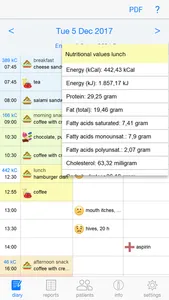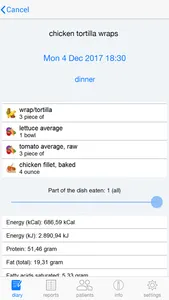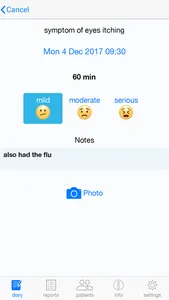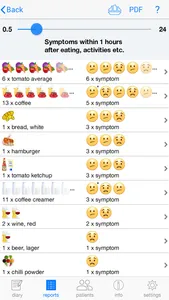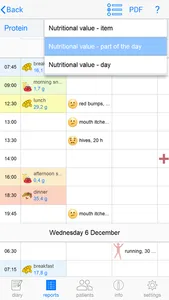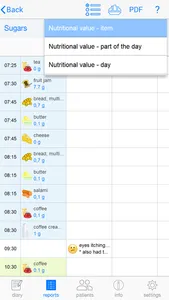FoodSQCare can only be used in combination with a third party (client or patient) using the app FoodSeeq.
- The E-health FoodSQCare app can be used, for example, by a dietitian to monitor the diary notes of diet and symptoms entered by a patient or client using the FoodSeeq app.
- Using FoodSQCare, a dietitian or healthcare provider can help patients much more efficiently: the app analyzes the diet and symptoms pattern and combines and shows frequently occurring combinations of symptoms and specific food items.
- If desired, the app provides insight into the nutritional value of the diet: based on the diary entries, the app calculates how much energy (calories), proteins, fats, minerals, vitamins the diet has provided.
- If the patient or client has created a synchronization code in FoodSeeq and has sent it to the dietitian or healthcare provider, he can enter the synchronization code in FoodSQCare. From that moment on, the care provider is able to monitor the diet and symptoms entered into the diary by the patient, and can also consult the analyses of possible combinations between diet and symptoms for this patient.
- Using FoodSQCare the healthcare provider can monitor several clients’ or patients’ diaries. Clients’ data are not stored within the app, and are only acquired when needed (remaining with the app only for as long as the app session’s duration) from a server database. The client can disable the synchronization code for his or her care provider at any time, after which the care provider is no longer able to monitor the client’s diary.
- The diary and analyses can be exported from FoodSQCare as PDF documents, which can easily be shared or included in a (digital) healthcare file.
FoodSeeq can be used for various conditions where food can cause symptoms, such as:
- Irritable Bowel Syndrome (IBS);
- Inflammatory Bowel Disease (IBD) such as Crohn's disease and ulcerative colitis;
- Gastroesophageal Reflux Disease (GERD);
- Histamine intolerance;
- Eczema;
- Migraine.
FoodSeeq can also help gain more insight into the impact of diet changes on symptoms when following a low FODMAP diet.
- The E-health FoodSQCare app can be used, for example, by a dietitian to monitor the diary notes of diet and symptoms entered by a patient or client using the FoodSeeq app.
- Using FoodSQCare, a dietitian or healthcare provider can help patients much more efficiently: the app analyzes the diet and symptoms pattern and combines and shows frequently occurring combinations of symptoms and specific food items.
- If desired, the app provides insight into the nutritional value of the diet: based on the diary entries, the app calculates how much energy (calories), proteins, fats, minerals, vitamins the diet has provided.
- If the patient or client has created a synchronization code in FoodSeeq and has sent it to the dietitian or healthcare provider, he can enter the synchronization code in FoodSQCare. From that moment on, the care provider is able to monitor the diet and symptoms entered into the diary by the patient, and can also consult the analyses of possible combinations between diet and symptoms for this patient.
- Using FoodSQCare the healthcare provider can monitor several clients’ or patients’ diaries. Clients’ data are not stored within the app, and are only acquired when needed (remaining with the app only for as long as the app session’s duration) from a server database. The client can disable the synchronization code for his or her care provider at any time, after which the care provider is no longer able to monitor the client’s diary.
- The diary and analyses can be exported from FoodSQCare as PDF documents, which can easily be shared or included in a (digital) healthcare file.
FoodSeeq can be used for various conditions where food can cause symptoms, such as:
- Irritable Bowel Syndrome (IBS);
- Inflammatory Bowel Disease (IBD) such as Crohn's disease and ulcerative colitis;
- Gastroesophageal Reflux Disease (GERD);
- Histamine intolerance;
- Eczema;
- Migraine.
FoodSeeq can also help gain more insight into the impact of diet changes on symptoms when following a low FODMAP diet.
Show More

